
Marble
Cleaning & Sealing Marble
Marble is a non-foliated metamorphic rock composed of re-crystallized carbonate minerals, most commonly calcite or dolomite. Marble was once limestone, compacted by heat and pressure that re-crystallized into marble when mineral changes occurred. This produces the colors and veining seen in the stone. Sealing marble is highly recommended as stain removal can be limited due to its chemical sensitivity.
POLISHED MARBLE
A glossy, highly reflective surface- Surface is very smooth and not very porous
- Polished crystals bring out brilliant colors and grains (400 to 3500 grit to polish stone)
- Shine comes from the natural reflection of the stone’s crystals
- Polish can wear away due to heavy foot traffic and improper maintenance
TUMBLED MARBLE
A slightly rough texture that is achieved by tumbling small pieces of marble, limestone or granite to achieve an old-world/worn appearanceHONED MARBLE
A flat matte to low sheen gloss- Surface is very smooth, but very porous
- Many more and wider gaps in surface than polished stone
- Medium density
- Commonly used in low traffic areas or for aesthetics
- Colors are not as vibrant as a polished stone
SAND BLASTED MARBLE
Pressurized flow of sand and water that results in a matte finishBUSH-HAMMERED MARBLE
Pounding action of hammer develops textured surface. Reduces stone’s color tones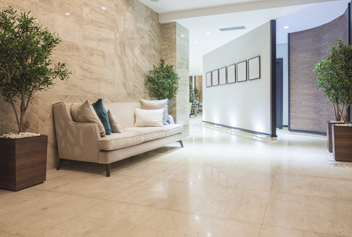
Sealing marble is highly recommended as stain removal can be limited due to its chemical sensitivity.
If you have a stain that you wish to remove, Aqua Mix® Poultice Stain Remover should be used. This product is a blend of absorbent clays that can be mixed with water or an appropriate chemical to extract the stain from within the stone.
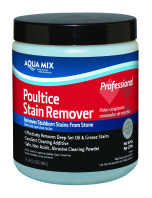
For polishing of large areas, Aqua Mix® Reviver should be used. For small minor etch marks, Aqua Mix® Renue should be used. For re-honing of Marble, Aqua Mix® KnockDown should be used.
Because carbonates (marble, travertine or limestone) react to acid (acidic liquids & cleaners) to create carbon dioxide, the effects to the stone are permanent. The destruction of carbonates shows on the surface of stone as etching. Although the particles of stone cannot be recovered, they can be polished or refinished to match the finish of the stone. Aqua Mix® have a range of Stone Restoration Products that are designed to repair and restore marble, travertine & limestone surfaces. It should be noted that penetrating sealers cannot stop acidic liquids from etching marble surfaces.
Countertops and Walls Sealing MarbleCountertops/Bench-tops, vanities and walls should be regularly cleaned using any of Aqua Mix® Routine Cleaners. Regular use of Aqua Mix® Aqua Shield™ Cleaner & Resealer will ensure that your marble always maintains maximum stain resistance. Aqua Mix® Brilliance is an excellent cleaner/polisher that adds luster to your polished marble, regular use helps protect factory polish. Floors Floors should be regularly cleaned using Aqua Mix® Concentrated Stone & Tile Cleaner. If the surface is allowed to build up, then scrub the surface using Aqua Mix® Stone Deep Clean, Aqua Mix® Heavy-Duty Tile & Grout Cleaner or Aqua Mix® NanoScrub® and an Aqua MIx® AquaScrub.

Smooth surfaces (polished, honed) should only be sealed using either a Natural Look Sealer or an Enhancing Sealer. The best sealer for marble is Aqua Mix® Sealer’s Choice® Gold – Rapid Cure, however we have a range of sealers to suit your requirements: Sealing Marble with a Natural Look Penetrating Sealer:
- Good: Aqua Mix® Penetrating Sealer
- Better: Aqua Mix® Pro-Solv®
- Best: Aqua Mix® Sealer’s Choice® Gold – Rapid Cure or Aqua Mix® Ultra-Solv®
- Good: Aqua Mix® Stone Enhancer
- Best: Aqua Mix® Enrich’N’Seal™
It is important that all of the grout haze is removed between 3-10 days. A minimum of 3 days for the the grout to cure and harden, and no longer than 10 days or it may need to be mechanically removed. Grout haze can be removed using Aqua Mix® NanoScrub®, if Aqua Mix® Grout Release was used, the grout and Grout Release can be removed using Aqua Mix® Heavy-Duty Tile & Grout Cleaner. If epoxy grout has been used you can remove using Aqua Mix® Sealer & Coating Remover.
If the stone does not require to be pre-sealed, it is generally recommended to apply a coat of sealer on the surface prior to grouting. This is to act as a grout release and assist in the grout clean-up process. This is very important as acidic cleaners cannot be used to removed cured grout residue. If the surface is textured (sandblasted, bush-hammered, tumbled) applying a coat of Aqua Mix® Grout Release would be work best. If the surface is smooth (polished, honed) than applying a coat of the final sealer you select is recommended.
Occasionally pre sealing marble is required prior to installation, especially lighter colors as they can become translucent when wet. It is always best to consult with your stone supplier to verify whether your marble requires this treatment. If required, sealing marble on all six sides using Aqua Mix® ProBlock a minimum of 24 hours prior to installation. Aqua Mix® ProBlock is a water based penetrating sealer designed to resist staining caused by water soluble minerals (including picture framing effect) which are normally absorbed through the back of the stone during installation. It also helps resist efflorescence migration. If applying an Enhancing Sealer as the final surface seal, DO NOT apply any ProBlock to the top surface as it will stop the penetration of enhancing sealers. Please contact Aqua Mix® prior to installation if an enhancer is specified for use.
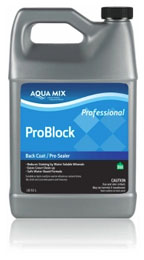

Limestone
Cleaning & Sealing Limestone
Limestone is a sedimentary rock composed largely of the minerals calcite and aragonite, which are different crystal forms of calcium carbonate (CaCO3). Most limestone is composed of skeletal fragments of marine organisms such as coral or foraminifera. Sealing limestone is highly recommended as stain removal can be limited due to its porosity and chemical sensitivity.
POLISHED LIMESTONE
A glossy, highly reflective surface- Surface is very smooth and not very porous
- Polished crystals bring out brilliant colors and grains (400 to 3500 grit to polish stone)
- Shine comes from the natural reflection of the stone’s crystals
- Polish can wear away due to heavy foot traffic and improper maintenance
TUMBLED LIMESTONEE
A slightly rough texture that is achieved by tumbling small pieces of marble, limestone or granite to achieve an old-world/worn appearanceHONED LIMESTONE
A flat matte to low sheen gloss- Surface is very smooth, but very porous
- Many more and wider gaps in surface than polished stone
- Medium density
- Commonly used in low traffic areas or for aesthetics
- Colors are not as vibrant as a polished stone
SAND BLASTED LIMESTONE
Pressurized flow of sand and water that results in a matte finishBUSH-HAMMERED LIMESTONE
Pounding action of hammer develops textured surface. Reduces stone’s color tones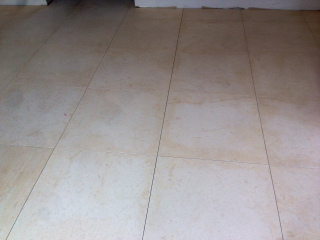
Sealing limestone is highly recommended as stain removal can be limited due to its porosity and chemical sensitivity.
If you have a stain that you wish to remove, Aqua Mix® Poultice Stain Remover should be used. This product is a blend of absorbent clays that can be mixed with water or an appropriate chemical to extract the stain from within the stone.

For polishing of large areas, Aqua Mix® Reviver should be used. For small minor etch marks, Aqua Mix® Renue should be used. For re-honing of Limestone, Aqua Mix® KnockDown should be used.
Because carbonates (marble, travertine or limestone) react to acid (acidic liquids & cleaners) to create carbon dioxide, the effects to the stone are permanent. The destruction of carbonates shows on the surface of stone as etching. Although the particles of stone cannot be recovered, they can be polished or refinished to match the finish of the stone. Aqua Mix® have a range of Stone Restoration Products that are designed to repair and restore marble, travertine & limestone surfaces. It should be noted that penetrating sealers cannot stop acidic liquids from etching limestone surfaces.
Countertops and Walls Sealing LimestoneCountertops/Bench-tops, vanities and walls should be regularly cleaned using any of Aqua Mix® Routine Cleaners. Regular use of Aqua Mix® Aqua Shield™ Cleaner & Resealer will ensure that your limestone always maintains maximum stain resistance. Aqua Mix® Brilliance is an excellent cleaner/polisher that adds luster to your polished limestone, regular use helps protect factory polish. Floors Floors should be regularly cleaned using Aqua Mix® Concentrated Stone & Tile Cleaner. If the surface is allowed to build up, then scrub the surface using Aqua Mix® Stone Deep Clean, Aqua Mix® Heavy-Duty Tile & Grout Cleaner or Aqua Mix® NanoScrub® and an Aqua MIx® AquaScrub.
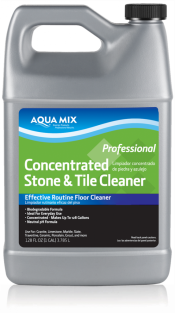
Smooth surfaces (polished, honed) should only be sealed using either a Natural Look Sealer or an Enhancing Sealer. The best sealer for marble is Aqua Mix® Sealer’s Choice® Gold – Rapid Cure, however we have a range of sealers to suit your requirements:
It is important that all of the grout haze is removed between 3-10 days. A minimum of 3 days for the the grout to cure and harden, and no longer than 10 days or it may need to be mechanically removed. Grout haze can be removed using Aqua Mix® NanoScrub®, if Aqua Mix® Grout Release was used, the grout and Grout Release can be removed usingAqua Mix®Heavy-Duty Tile & Grout Cleaner. If epoxy grout has been used you can remove using Aqua Mix® Sealer & Coating Remover.
If the stone does not require to be pre-sealed, it is generally recommended to apply a coat of sealer on the surface prior to grouting. This is to act as a grout release and assist in the grout clean-up process. This is very important as acidic cleaners cannot be used to removed cured grout residue. If the surface is textured (sandblasted, bush-hammered, tumbled) applying a coat of Aqua Mix® Grout Release would be work best. If the surface is smooth (polished, honed) than applying a coat of the final sealer you select is recommended.
Pre sealing limestone is highly recommended prior to installation. Many Limestones contain soluble salts and can often become permanently discoloured from the installation process. It is always best to consult with your stone supplier to verify whether your limestone requires this treatment. For best results, sealing limestone on all six sides using Aqua Mix® ProBlock a minimum of 24 hours prior to installation. Aqua Mix® ProBlock is a water based penetrating sealer designed to resist staining caused by water soluble minerals (including picture framing effect) which are normally absorbed through the back of the stone during installation. It also helps resist efflorescence migration. If applying an Enhancing Sealer as the final surface seal, DO NOT apply any ProBlock to the top surface as it will stop the penetration of enhancing sealers. Please contact Aqua Mix® prior to installation if an enhancer is specified for use.


Travertine
Cleaning & Sealing Travertine
Travertine is a form of limestone deposited by mineral springs, especially hot springs. Travertine often has a fibrous or concentric appearance and exists in white, tan, cream-colored, and even rusty varieties. It is formed by a process of rapid precipitation of calcium carbonate, often at the mouth of a hot spring or in a limestone cave. Sealing travertine is highly recommended as stain removal can be limited due to its chemical sensitivity.
POLISHED TRAVERTINE
A glossy, highly reflective surface- Surface is very smooth and not very porous
- Polished crystals bring out brilliant colors and grains (400 to 3500 grit to polish stone)
- Shine comes from the natural reflection of the stone’s crystals
- Polish can wear away due to heavy foot traffic and improper maintenance
TUMBLED TRAVERTINE
A slightly rough texture that is achieved by tumbling small pieces of marble, limestone or granite to achieve an old-world/worn appearanceHONED TRAVERTINE
A flat matte to low sheen gloss- Surface is very smooth, but very porous
- Many more and wider gaps in surface than polished stone
- Medium density
- Commonly used in low traffic areas or for aesthetics
- Colors are not as vibrant as a polished stone
SAND BLASTED TRAVERTINE
Pressurized flow of sand and water that results in a matte finishBUSH-HAMMERED LIMESTONE
Pounding action of hammer develops textured surface. Reduces stone’s color tones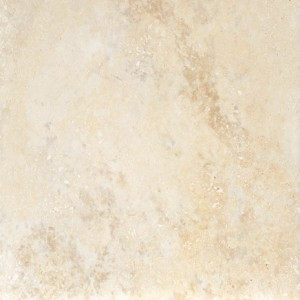
Sealing travertine is highly recommended as stain removal can be limited due to its chemical sensitivity.
If you have a stain that you wish to remove, Aqua Mix® Poultice Stain Remover should be used. This product is a blend of absorbent clays that can be mixed with water or an appropriate chemical to extract the stain from within the stone.

For polishing of large areas, Aqua Mix® Reviver should be used. For small minor etch marks, Aqua Mix® Renue should be used. For re-honing of Travertine, Aqua Mix® KnockDown should be used.
Because carbonates (marble, travertine or limestone) react to acid (acidic liquids & cleaners) to create carbon dioxide, the effects to the stone are permanent. The destruction of carbonates shows on the surface of stone as etching. Although the particles of stone cannot be recovered, they can be polished or refinished to match the finish of the stone. Aqua Mix® have a range of Stone Restoration Products that are designed to repair and restore marble, travertine & limestone surfaces. It should be noted that penetrating sealers cannot stop acidic liquids from etching travertine surfaces.
Countertops and Walls Countertops/Bench-tops, vanities and walls should be regularly cleaned using any of Aqua Mix® Routine Cleaners. Regular use of Aqua Mix® Aqua Shield™ Cleaner & Resealer will ensure that your travertine always maintains maximum stain resistance. Aqua Mix® Brilliance is an excellent cleaner/polisher that adds luster to your polished travertine, regular use helps protect factory polish. Floors Floors should be regularly cleaned using Aqua Mix® Concentrated Stone & Tile Cleaner. If the surface is allowed to build up, then scrub the surface using Aqua Mix® Stone Deep Clean, Aqua Mix® Heavy-Duty Tile & Grout Cleaner or Aqua Mix® NanoScrub® and an Aqua MIx® AquaScrub.

Smooth surfaces (polished, honed) should only be sealed using either a Natural Look Sealer or an Enhancing Sealer. The best sealer for Travertine is Aqua Mix® Sealer’s Choice® Gold – Rapid Cure, however we have a range of sealers to suit your requirements: Sealing Travertine with a Natural Look Penetrating Sealer:
- Good: Aqua Mix® Penetrating Sealer
- Better: Aqua Mix® Pro-Solv®
- Best: Aqua Mix® Sealer’s Choice® Gold – Rapid Cure or Aqua Mix® Ultra-Solv®
- Good: Aqua Mix® Stone Enhancer
- Best: Aqua Mix® Enrich’N’Seal™
It is important that all of the grout haze is removed between 3-10 days. A minimum of 3 days for the the grout to cure and harden, and no longer than 10 days or it may need to be mechanically removed. Grout haze can be removed using Aqua Mix® NanoScrub®, if Aqua Mix® Grout Release was used, the grout and Grout Release can be removed usingAqua Mix® Heavy-Duty Tile & Grout Cleaner. If epoxy grout has been used you can remove using Aqua Mix® Sealer & Coating Remover.
If the stone does not require to be pre-sealed, it is generally recommended to apply a coat of sealer on the surface prior to grouting. This is to act as a grout release and assist in the grout clean-up process. This is very important as acidic cleaners cannot be used to removed cured grout residue. If the surface is textured (sandblasted, bush-hammered, tumbled) applying a coat of Aqua Mix® Grout Release would be work best. If the surface is smooth (polished, honed) than applying a coat of the final sealer you select is recommended.
Pre sealing travertine is not often required, however it is always best to consult with your stone supplier to verify whether your travertine requires this treatment. If required, sealing travertine on all six sides using Aqua Mix® ProBlock a minimum of 24 hours prior to installation. Aqua Mix® ProBlock is a water based penetrating sealer designed to resist staining caused by water soluble minerals (including picture framing effect) which are normally absorbed through the back of the stone during installation. It also helps resist efflorescence migration. If applying an Enhancing Sealer as the final surface seal, DO NOT apply any ProBlock to the top surface as it will stop the penetration of enhancing sealers. Please contact Aqua Mix® prior to installation if an enhancer is specified for use.

Granite
Cleaning & Sealing Granite
By definition, granite is an igneous rock with at least 20% quartz and up to 65% alkali feldspar by volume. Granite differs from granodiorite in that at least 35% of the feldspar in granite is alkali feldspar as opposed to plagioclase; it is the potassium feldspar that gives many granites a distinctive pink color. The extrusive igneous rock equivalent of granite is rhyolite. Granite is very dense and has a high resistance to chemicals. Sealing granite is recommended to seal for stain resistance and maintenance purposes.
POLISHED GRANITE
A glossy, highly reflective surface- Surface is very smooth and not very porous
- Polished crystals bring out brilliant colors and grains (400 to 3500 grit to polish stone)
- Shine comes from the natural reflection of the stone’s crystals
- Polish can wear away due to heavy foot traffic and improper maintenance
TUMBLED GRANITE
A slightly rough texture that is achieved by tumbling small pieces of marble, limestone or granite to achieve an old-world/worn appearanceHONED GRANITE
A flat matte to low sheen gloss- Surface is very smooth, but very porous
- Many more and wider gaps in surface than polished stone
- Medium density
- Commonly used in low traffic areas or for aesthetics
- Colors are not as vibrant as a polished stone
SAND BLASTED GRANITE
Pressurized flow of sand and water that results in a matte finishBUSH-HAMMERED GRANITE
Pounding action of hammer develops textured surface. Reduces stone’s color tones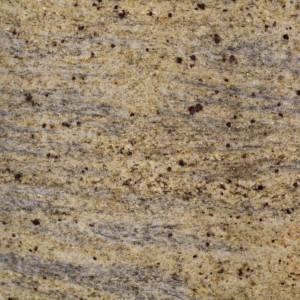
Sealing granite is recommended to seal for stain resistance and maintenance purposes.
Smooth surfaces (polished, honed) should only be sealed using either a Natural Look Sealer or an Enhancing Sealer. The best sealer for Granite is Aqua Mix® Sealer’s Choice® Gold – Rapid Cure, however we have a range of sealers to suit your requirements: Sealing Granite with a Natural Look Penetrating Sealer:
- Good: Aqua Mix® Penetrating Sealer
- Better: Aqua Mix® Pro-Solv®
- Best: Aqua Mix® Sealer’s Choice® Gold – Rapid Cure or Aqua Mix® Ultra-Solv®
- Good: Aqua Mix® Stone Enhancer
- Best: Aqua Mix® Enrich’N’Seal™
Countertops and Walls Countertops/Bench-tops, vanities and walls should be regularly cleaned using any of Aqua Mix® Routine Cleaners. Regular use of Aqua Mix® Aqua Shield™ Cleaner & Resealer will ensure that your granite always maintains maximum stain resistance. Aqua Mix® Brilliance is an excellent cleaner/polisher that adds luster to your polished granite, regular use helps protect factory polish. Floors Floors should be regularly cleaned using Aqua Mix® Concentrated Stone & Tile Cleaner. If the surface is allowed to build up, then scrub the surface using Aqua Mix® Stone Deep Clean, Aqua Mix® Heavy-Duty Tile & Grout Cleaner or Aqua Mix® NanoScrub® and an Aqua MIx® AquaScrub.

It is important that all of the grout haze is removed between 3-10 days. A minimum of 3 days for the the grout to cure and harden, and no longer than 10 days or it may need to be mechanically removed. Grout haze can be removed using Aqua Mix® Phosphoric Acid Substitute. It should be noted that many basalts are being called “granite” and many can react with acidic cleaners. It is always recommended that you test Aqua Mix® Phosphoric Acid Substitute on a spare piece first. If Aqua Mix® Grout Release was used, the grout and Grout Release can be removed using Aqua Mix® Heavy-Duty Tile & Grout Cleaner. If epoxy grout has been used you can remove using Aqua Mix® Sealer & Coating Remover.
If the stone does not require to be pre-sealed, it is generally recommended to apply a coat of sealer on the surface prior to grouting. This is to act as a grout release and assist in the grout clean-up process. If the surface is textured (sandblasted, bush-hammered, tumbled) applying a coat of Aqua Mix® Grout Release would be work best. If the surface is smooth (polished, honed) than applying a coat of the final sealer you select is recommended.
Pre sealing granite is not always required, however it is always best to consult with your stone supplier to verify whether your granite requires this treatment. Light coloured granites are more likely to suffer from water soluble minerals (including picture framing effect) being absorbed through the back of the stone during installation. If required, sealing granite on all six sides using Aqua Mix® ProBlock a minimum of 24 hours prior to installation. Aqua Mix® ProBlock is a water based penetrating sealer designed to resist staining caused by water soluble minerals (including picture framing effect) which are normally absorbed through the back of the stone during installation. It also helps resist efflorescence migration. If applying an Enhancing Sealer as the final surface seal, DO NOT apply any ProBlock to the top surface as it will stop the penetration of enhancing sealers. Please contact Aqua Mix® prior to installation if an enhancer is specified for use.
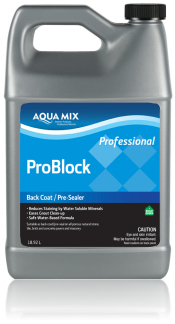
If you have a stain that you wish to remove, Aqua Mix® Poultice Stain Remover should be used. This product is a blend of absorbent clays that can be mixed with water or an appropriate chemical to extract the stain from within the stone.


Sandstone
Cleaning & Sealing Sandstone
Sandstone is a clastic sedimentary rock composed mainly of sand-sized minerals or rock grains. Most sandstone is composed of quartz and/or feldspar because these are the most common minerals in the Earth’s crust. Like sand, sandstone may be any color, but the most common colors are tan, brown, yellow, red, grey, pink, white and black. Since sandstone beds often form highly visible cliffs and other topographic features, certain colours of sandstone have been strongly identified with certain regions. Sealing Sandstone is highly recommended as stain removal can be limited due to its porosity and texture.
TUMBLED SANDSTONE
A slightly rough texture that is achieved by tumbling small pieces of sandstone to achieve an old-world/worn appearanceHONED SANDSTONE
A flat matte to low sheen gloss- Surface is very smooth, but very porous
- Medium density
- Commonly used in low traffic areas or for aesthetics
SAND BLASTED SANDSTONE
Pressurized flow of sand and water that results in a matte finishSAWN SANDSTONE
The sandstone is sawn from the quarry. This is a raw finish with slight grooves left in the surface.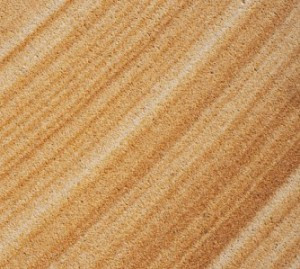
Sealing Sandstone is highly recommended as stain removal can be limited due to its porosity and texture.
Countertops and Walls Sealing SandstoneCountertops/Bench-tops, vanities and walls should be regularly cleaned using any of Aqua Mix® Routine Cleaners. Regular use of Aqua Mix® Aqua Shield™ Cleaner & Resealer will ensure that your Sandstone always maintains maximum stain resistance. Floors Floors should be regularly cleaned using Aqua Mix® Concentrated Stone & Tile Cleaner. If the surface is allowed to build up, then scrub the surface using Aqua Mix® Stone Deep Clean, Aqua Mix® Heavy-Duty Tile & Grout Cleaner or Aqua Mix® NanoScrub® and an Aqua MIx® AquaScrub.

Smooth surfaces (honed) should only be sealed using either a Natural Look Sealer or an Enhancing Sealer. The best sealer for Sandstone is Aqua Mix® Sealer’s Choice® Gold – Rapid Cure, however we have a range of sealers to suit your requirements: Sealing Sandstone with a Natural Look Penetrating Sealer:
- Good: Aqua Mix® Penetrating Sealer
- Better: Aqua Mix® Pro-Solv®
- Best: Aqua Mix® Sealer’s Choice® Gold – Rapid Cure or Aqua Mix® Ultra-Solv®
- Good: Aqua Mix® Stone Enhancer
- Best: Aqua Mix® Enrich’N’Seal™
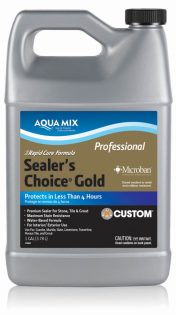
It is important that all of the grout haze is removed between 3-10 days. A minimum of 3 days for the the grout to cure and harden, and no longer than 10 days or it may need to be mechanically removed. Grout haze can be removed using Aqua Mix® Phosphoric Acid Substitute. It is recommended whenever using acidic cleaners that you test Aqua Mix® Phosphoric Acid Substitute on a spare piece first. If Aqua Mix® Grout Release was used, the grout and Grout Release can be removed using Aqua Mix® Heavy-Duty Tile & Grout Cleaner. If epoxy grout has been used you can remove using Aqua Mix® Sealer & Coating Remover.
If the sandstone does not require to be pre-sealed, it is generally recommended to apply a coat of sealer on the surface prior to grouting. This is to act as a grout release and assist in the grout clean-up process. If the surface is textured (sandblasted, bush-hammered, tumbled) applying a coat of Aqua Mix® Grout Release would be work best. If the surface is smooth (polished, honed) than applying a coat of the final sealer you select is recommended.
Pre sealing sandstone is recommended prior to installation. It is always best to consult with your stone supplier to verify whether your sandstone requires this treatment. For best results, sealing sandstone on all six sides using Aqua Mix® ProBlock a minimum of 24 hours prior to installation. Aqua Mix® ProBlock is a water based penetrating sealer designed to resist staining caused by water soluble minerals (including picture framing effect) which are normally absorbed through the back of the stone during installation. It also helps resist efflorescence migration. If applying an Enhancing Sealer as the final surface seal, DO NOT apply any ProBlock to the top surface as it will stop the penetration of enhancing sealers. Please contact Aqua Mix® prior to installation if an enhancer is specified for use.
If you have a stain that you wish to remove, Aqua Mix® Poultice Stain Remover should be used. This product is a blend of absorbent clays that can be mixed with water or an appropriate chemical to extract the stain from within the stone.


Porcelain Tiles
Cleaning & Sealing Porcelain Tiles
Porcelain tiles are ceramic tiles with a water absorption rate of less than 0.5 percent that are used to cover floors and walls. They can either be unglazed or glazed and are available in a variety of colours, textures and finishes. Porcelain is much harder than ordinary ceramic tiles and is usually selected, despite its higher price etc. in areas where strength is more important, such as floors and commercial use, or in areas of high wear and hard knocks. Sealing porcelain tiles may be required, it is always best to consult with your tile supplier to verify whether your porcelain tiles require this treatment.
POLISHED PORCELAIN TILES
A glossy, highly reflective surface- Surface is very smooth and reflective
- The polishing process creates micro pores on the surface which are subject to staining
- Sometimes has a wax or pre sealer applied during manufacturing process
HONED PORCELAIN TILES
A flat matte to low sheen gloss- Surface is very smooth
- Sometimes has a wax or pre sealer applied during manufacturing process
TEXTURED PORCELAIN TILES
A rough textured non sheen finish- Ideal for external use
- Non slip texture
GLAZED PORCELAIN TILES
A glossy, reflective surface- Sealing is not necessary
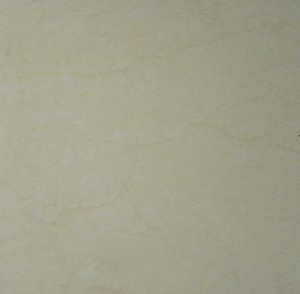
Sealing porcelain tiles may be required, it is always best to consult with your tile supplier to verify whether your porcelain tiles require this treatment.
Countertops and Walls Sealing Porcelain TilesCountertops/Bench-tops, vanities and walls should be regularly cleaned using any of Aqua Mix® Routine Cleaners. Regular use of Aqua Mix® Aqua Shield™ Cleaner & Resealer will ensure that your porcelain always maintains maximum stain resistance. Floors Floors should be regularly cleaned using Aqua Mix® Concentrated Stone & Tile Cleaner. If the surface is allowed to build up, then scrub the surface using Aqua Mix® Stone Deep Clean, Aqua Mix® Heavy-Duty Tile & Grout Cleaner or Aqua Mix® NanoScrub® and an Aqua MIx® AquaScrub.

In most cases you should only be sealing these tiles using either a Natural Look Sealer or an Enhancing Sealer. The best sealer for porcelain tiles is Aqua Mix® Sealer’s Choice® Gold – Rapid Cure, however we have a range of sealers to suit your requirements: Sealing Porcelain Tiles with a Natural Look Penetrating Sealer:
- Good: Aqua Mix® Penetrating Sealer
- Better: Aqua Mix® Pro-Solv®
- Best: Aqua Mix® Sealer’s Choice® Gold – Rapid Cure or Aqua Mix® Ultra-Solv®
- Good: Aqua Mix® Stone Enhancer
- Best: Aqua Mix® Enrich’N’Seal™
If the factory wax was not completely removed during the grout haze removal process, the surface should be scrubbed using Aqua Mix® NanoScrub® and an Aqua MIx® AquaScrub.

It is best that all of the grout haze is removed between 3-10 days. A minimum of 3 days for the the grout to cure and harden, and no longer than 10 days or it will be more difficult to remove. Aqua Mix® Grout Haze Clean-Up can be used within first 10 days of grouting. If the grout has been left for more than 10 days grout haze can be removed using Aqua Mix® Phosphoric Acid Substitute. If epoxy grout has been used you can remove using Aqua Mix® Sealer & Coating Remover. If Aqua Mix® Grout Release was used, the grout and Grout Release can be removed using Aqua Mix® Heavy-Duty Tile & Grout Cleaner.
In most cases pre-grout sealing porcelain tiles prior to grouting or installation is not required. However if a dark coloured grout or an epoxy grout is being used it may require an application of a pre-grout sealer. This is to prevent grout staining and also acts as a grout release and assist in the grout clean-up process. If the surface is textured applying a coat of Aqua Mix® Grout Release can be used. If the surface is smooth (polished, honed) than applying a coat of the final sealer you select is recommended.
If you have a stain that you wish to remove, Aqua Mix® Poultice Stain Remover should be used. This product is a blend of absorbent clays that can be mixed with water or an appropriate chemical to extract the stain from within the stone.


Bluestone/Basalt
Cleaning & Sealing Bluestone / Basalt
Basalt is a common extrusive igneous (volcanic) rock formed from the rapid cooling of basaltic lava exposed at or very near the surface of a planet or moon. Basalt is defined by its mineral content and texture, and physical descriptions without mineralogical context may be unreliable in some circumstances. Basalt is usually grey to black in colour, but rapidly weathers to brown or rust-red due to oxidation of its mafic (iron-rich) minerals into rust. Sealing bluestone is recommended for stain resistance and maintenance purposes.
POLISHED BLUESTONE/BASALT
A glossy, highly reflective surface- Surface is very smooth and not very porous
- Polished crystals bring out brilliant colors and grains (400 to 3500 grit to polish stone)
- Shine comes from the natural reflection of the stone’s crystals
- Polish can wear away due to heavy foot traffic and improper maintenance
TUMBLED BLUESTONE/BASALT
A slightly rough texture that is achieved by tumbling small pieces of marble, limestone or granite to achieve an old-world/worn appearanceHONED BLUESTONE/BASALT
A flat matte to low sheen gloss- Surface is very smooth, but very porous
- Many more and wider gaps in surface than polished stone
- Medium density
- Commonly used in low traffic areas or for aesthetics
- Colors are not as vibrant as a polished stone
SAND BLASTED BLUESTONE/BASALT
Pressurized flow of sand and water that results in a matte finishBUSH-HAMMERED BLUESTONE/BASALT
Pounding action of hammer develops textured surface. Reduces stone’s color tones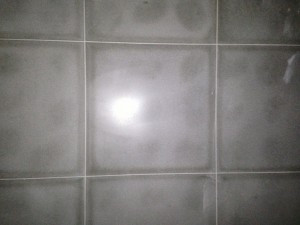
Sealing bluestone is recommended for stain resistance and maintenance purposes.
Countertops and Walls
Countertops/Bench-tops, vanities and walls should be regularly cleaned using any of Aqua Mix® Routine Cleaners.
Regular use of Aqua Mix® Aqua Shield™ Cleaner & Resealer will ensure that your bluestone / basalt always maintains maximum stain resistance.
Aqua Mix® Brilliance is an excellent cleaner/polisher that adds luster to your polished bluestone / basalt, regular use helps protect factory polish.
Floors
Floors should be regularly cleaned using Aqua Mix® Concentrated Stone & Tile Cleaner. If the surface is allowed to build up, then scrub the surface using Aqua Mix® Stone Deep Clean, Aqua Mix® Heavy-Duty Tile & Grout Cleaner or Aqua Mix® NanoScrub® and an Aqua MIx® AquaScrub.

Smooth surfaces (polished, honed) should only be sealed using either a Natural Look Sealer or an Enhancing Sealer. The best sealer for bluestone / basalt is Aqua Mix® Sealer’s Choice® Gold – Rapid Cure, however we have a range of sealers to suit your requirements: Sealing Bluestone / Basalt with a Natural Look Penetrating Sealer:
- Good: Aqua Mix® Penetrating Sealer
- Better: Aqua Mix® Pro-Solv®
- Best: Aqua Mix® Sealer’s Choice® Gold – Rapid Cure or Aqua Mix® Ultra-Solv®
- Good: Aqua Mix® Stone Enhancer
- Best: Aqua Mix® Enrich’N’Seal™

It is important that all of the grout haze is removed between 3-10 days. A minimum of 3 days for the the grout to cure and harden, and no longer than 10 days or it may need to be mechanically removed. Grout haze can be removed using Aqua Mix® Phosphoric Acid Substitute. It should be noted that many basalts can react with acidic cleaners. It is always recommended that you test Aqua Mix® Phosphoric Acid Substitute on a spare piece first. If Aqua Mix® Grout Release was used, the grout and Grout Release can be removed using Aqua Mix® Heavy-Duty Tile & Grout Cleaner. If epoxy grout has been used you can remove using Aqua Mix® Sealer & Coating Remover.
If the stone does not require to be pre-sealed, it is generally recommended to apply a coat of sealer on the surface prior to grouting. This is to act as a grout release and assist in the grout clean-up process. If the surface is textured (sandblasted, bush-hammered, tumbled) applying a coat of Aqua Mix® Grout Release would be work best. If the surface is smooth (polished, honed) than applying a coat of the final sealer you select is recommended.
Sealing bluestone is highly recommended prior to installation. Many bluestone/basalt contain soluble salts and can often become permanently discoloured from the installation process. It is always best to consult with your stone supplier to verify whether your bluestone requires this treatment. For best results, sealing bluestone on all six sides using Aqua Mix® ProBlock a minimum of 24 hours prior to installation. Aqua Mix® ProBlock is a water based penetrating sealer designed to resist staining caused by water soluble minerals (including picture framing effect) which are normally absorbed through the back of the stone during installation. It also helps resist efflorescence migration. If applying an Enhancing Sealer as the final surface seal, DO NOT apply any ProBlock to the top surface as it will stop the penetration of enhancing sealers. Please contact Aqua Mix® prior to installation if an enhancer is specified for use.
If you have a stain that you wish to remove, Aqua Mix® Poultice Stain Remover should be used. This product is a blend of absorbent clays that can be mixed with water or an appropriate chemical to extract the stain from within the stone.

